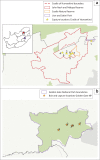Antibody response to Raboral VR-G® oral rabies vaccine in captive and free-ranging black-backed jackals (Canis mesomelas)
- PMID: 35144442
- PMCID: PMC8905486
- DOI: 10.4102/ojvr.v89i1.1975
Antibody response to Raboral VR-G® oral rabies vaccine in captive and free-ranging black-backed jackals (Canis mesomelas)
Abstract
Rabies is a zoonotic disease that remains endemic in large parts of southern Africa because of its persistence in wildlife and domestic dog vectors. The black-backed jackals (Canis mesomelas) is primarily the wildlife vector responsible for rabies outbreaks in northern parts of South Africa. Two trials were carried out to investigate antibody responses to the oral rabies vaccine Raboral V-RG® in black-backed jackals under captive and free-ranging conditions. In captive jackals 10/12 (83%; 95% confidence interval [CI]: 52% - 98%), seroconverted after single oral vaccination. Nine captive jackals had protective antibody titres ( 0.5 IU/mL) at 4 weeks (median: 2.1 IU/mL; inter quartile range [IQR]: 0.6-5.7) and 10 jackals had at 12 weeks (median: 3.5 IU/mL; IQR: 1.5-8.3) and three maintained antibody titres for up to 48 weeks (median: 3.4 IU/mL; IQR: 2.0-6.3). Four sites were baited with Raboral V-RG® vaccine for wild jackals, using fishmeal polymer and chicken heads. Baits were distributed by hand or from vehicle at three sites in north-eastern South Africa, with an average baiting density of 4.4 baits/km2 and at one site in central South Africa, at 0.12 baits/km2. This resulted in protective antibody titres in 3/11 jackals (27%; 95% Cl: 6-61) trapped between 3 and 12 months after baiting in north-eastern South Africa, compared with 4/7 jackals (57%; 95% Cl: 18-90) trapped after 3-18 months in central South Africa. This study shows the potential utility of oral rabies vaccination for the control of wildlife-associated rabies in north-eastern and central South Africa, but extensive studies with wider distribution of bait are needed to assess its potential impact on rabies control in wild jackals.
Keywords: Canis mesomelas; South Africa; black-backed jackal; oral bait; rabies; vaccination.
Conflict of interest statement
The authors declare that they have no financial or personal relationships that may have inappropriately influenced them in writing this article.
Figures



Similar articles
-
Oral bait preferences for rabies vaccination in free-ranging black-backed jackal (Canis mesomelas) and non-target species in a multi-site field study in a peri-urban protected area in South Africa.Prev Vet Med. 2020 Feb;175:104867. doi: 10.1016/j.prevetmed.2019.104867. Epub 2019 Dec 16. Prev Vet Med. 2020. PMID: 31927421
-
Molecular epidemiology of rabies: focus on domestic dogs (Canis familiaris) and black-backed jackals (Canis mesomelas) from northern South Africa.Virus Res. 2009 Mar;140(1-2):71-8. doi: 10.1016/j.virusres.2008.11.004. Epub 2008 Dec 20. Virus Res. 2009. PMID: 19061924
-
Rabies outbreak in black-backed jackals (Canis mesomelas), South Africa, 2016.Epidemiol Infect. 2022 Jan 7;150:e137. doi: 10.1017/S0950268821002685. Epidemiol Infect. 2022. PMID: 35900135 Free PMC article.
-
Oral vaccination of wildlife using a vaccinia-rabies-glycoprotein recombinant virus vaccine (RABORAL V-RG®): a global review.Vet Res. 2017 Sep 22;48(1):57. doi: 10.1186/s13567-017-0459-9. Vet Res. 2017. PMID: 28938920 Free PMC article. Review.
-
Efficacy and bait acceptance of vaccinia vectored rabies glycoprotein vaccine in captive foxes (Vulpes vulpes), raccoon dogs (Nyctereutes procyonoides) and dogs (Canis familiaris).Vaccine. 2008 Aug 26;26(36):4627-38. doi: 10.1016/j.vaccine.2008.06.089. Epub 2008 Jul 11. Vaccine. 2008. PMID: 18620017 Review.
Cited by
-
Temporal and Spatial Analysis of Rabies Virus Lineages in South Africa.Viruses. 2025 Feb 28;17(3):340. doi: 10.3390/v17030340. Viruses. 2025. PMID: 40143269 Free PMC article.
-
Vaccine Strategies to Elicit Mucosal Immunity.Vaccines (Basel). 2024 Feb 13;12(2):191. doi: 10.3390/vaccines12020191. Vaccines (Basel). 2024. PMID: 38400174 Free PMC article. Review.
References
-
- Bellan, S.E., Cizauskas, C.A., Miyen, J., Ebersohn, K., Küsters, M., Prager, K.C. et al. , 2012, ‘Black-backed jackal exposure to rabies virus, canine distemper virus, and Bacillus anthracis in Etosha National Park, Namibia’, Journal of Wildlife Diseases 48(2), 371–381. 10.7589/0090-3558-48.2.371 - DOI - PMC - PubMed
-
- Bingham, J. & Foggin, C.M., 1993, ‘Jackal rabies in Zimbabwe’, The Onderstepoort Journal of Veterinary Research 60, 365–366. - PubMed
-
- Bingham, J. & Purchase, G.K., 2003, ‘Age determination in jackals (Canis adustus Sundevall, 1846, and Canis mesomelas Schreber, 1778; Carnivora: Canidae) with reference to the age structure and breeding patterns of jackal populations in Zimbabwe’, African Zoology 38(1), 153–160. 10.1080/15627020.2003.11657203 - DOI
MeSH terms
Substances
LinkOut - more resources
Full Text Sources
Medical
